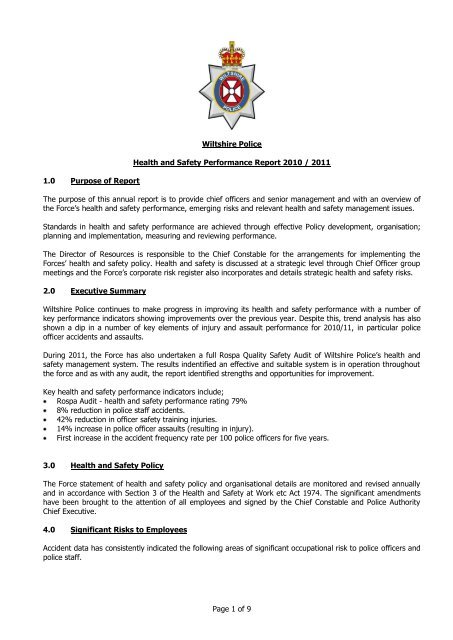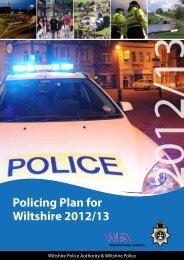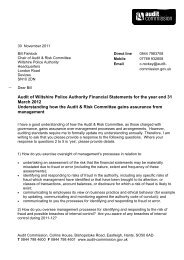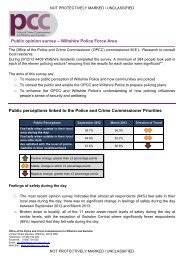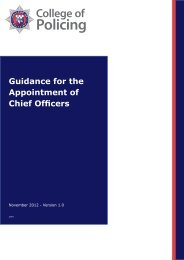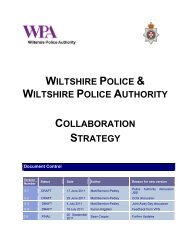Agenda item 14 - Health and Safety - Annual performance report
Agenda item 14 - Health and Safety - Annual performance report
Agenda item 14 - Health and Safety - Annual performance report
You also want an ePaper? Increase the reach of your titles
YUMPU automatically turns print PDFs into web optimized ePapers that Google loves.
1.0 Purpose of Report<br />
Wiltshire Police<br />
<strong>Health</strong> <strong>and</strong> <strong>Safety</strong> Performance Report 2010 / 2011<br />
The purpose of this annual <strong>report</strong> is to provide chief officers <strong>and</strong> senior management <strong>and</strong> with an overview of<br />
the Force’s health <strong>and</strong> safety <strong>performance</strong>, emerging risks <strong>and</strong> relevant health <strong>and</strong> safety management issues.<br />
St<strong>and</strong>ards in health <strong>and</strong> safety <strong>performance</strong> are achieved through effective Policy development, organisation;<br />
planning <strong>and</strong> implementation, measuring <strong>and</strong> reviewing <strong>performance</strong>.<br />
The Director of Resources is responsible to the Chief Constable for the arrangements for implementing the<br />
Forces’ health <strong>and</strong> safety policy. <strong>Health</strong> <strong>and</strong> safety is discussed at a strategic level through Chief Officer group<br />
meetings <strong>and</strong> the Force’s corporate risk register also incorporates <strong>and</strong> details strategic health <strong>and</strong> safety risks.<br />
2.0 Executive Summary<br />
Wiltshire Police continues to make progress in improving its health <strong>and</strong> safety <strong>performance</strong> with a number of<br />
key <strong>performance</strong> indicators showing improvements over the previous year. Despite this, trend analysis has also<br />
shown a dip in a number of key elements of injury <strong>and</strong> assault <strong>performance</strong> for 2010/11, in particular police<br />
officer accidents <strong>and</strong> assaults.<br />
During 2011, the Force has also undertaken a full Rospa Quality <strong>Safety</strong> Audit of Wiltshire Police’s health <strong>and</strong><br />
safety management system. The results indentified an effective <strong>and</strong> suitable system is in operation throughout<br />
the force <strong>and</strong> as with any audit, the <strong>report</strong> identified strengths <strong>and</strong> opportunities for improvement.<br />
Key health <strong>and</strong> safety <strong>performance</strong> indicators include;<br />
Rospa Audit - health <strong>and</strong> safety <strong>performance</strong> rating 79%<br />
8% reduction in police staff accidents.<br />
42% reduction in officer safety training injuries.<br />
<strong>14</strong>% increase in police officer assaults (resulting in injury).<br />
First increase in the accident frequency rate per 100 police officers for five years.<br />
3.0 <strong>Health</strong> <strong>and</strong> <strong>Safety</strong> Policy<br />
The Force statement of health <strong>and</strong> safety policy <strong>and</strong> organisational details are monitored <strong>and</strong> revised annually<br />
<strong>and</strong> in accordance with Section 3 of the <strong>Health</strong> <strong>and</strong> <strong>Safety</strong> at Work etc Act 1974. The significant amendments<br />
have been brought to the attention of all employees <strong>and</strong> signed by the Chief Constable <strong>and</strong> Police Authority<br />
Chief Executive.<br />
4.0 Significant Risks to Employees<br />
Accident data has consistently indicated the following areas of significant occupational risk to police officers <strong>and</strong><br />
police staff.<br />
Page 1 of 9
Police Officers<br />
Prisoner h<strong>and</strong>ling injuries<br />
Assaults<br />
Slips, trips <strong>and</strong> falls<br />
These combined occupational risks<br />
account for approximately 65% of all<br />
<strong>report</strong>ed accidents <strong>and</strong> injuries to<br />
operational police officers.<br />
Police Staff<br />
Slips, trips <strong>and</strong> falls<br />
Hit stationery object<br />
Hit by moving object<br />
These combined occupational risks<br />
account for approximately 53% of all<br />
<strong>report</strong>ed accidents <strong>and</strong> injuries to police<br />
staff.<br />
5.0 <strong>Health</strong> <strong>and</strong> <strong>Safety</strong> Strategy 2008-2013<br />
The Forces health <strong>and</strong> safety objectives are recorded within the <strong>Health</strong> <strong>and</strong> <strong>Safety</strong> Strategy 2008 - 2013. The<br />
strategy includes: -<br />
Overall health <strong>and</strong> safety strategy for the five-year period 2008 – 2013.<br />
<strong>Annual</strong> health <strong>and</strong> safety objectives with measurable targets in support of the overall health <strong>and</strong> safety<br />
strategy.<br />
Specific methodologies recorded as to how the annual health <strong>and</strong> safety objectives would be achieved<br />
The annual health <strong>and</strong> safety objectives are linked with the overall Human Resources Services Departmental<br />
Plan <strong>and</strong> <strong>performance</strong> <strong>report</strong>s.<br />
Reproduced at Appendix A to this <strong>report</strong> is a summary of the actual <strong>performance</strong> made in meeting the annual<br />
health <strong>and</strong> safety objectives for the financial year 2010/11. It is pleasing to <strong>report</strong>: -<br />
A total of five key objectives were progressed during the year.<br />
Four of the five (80%) health <strong>and</strong> safety objectives have been met <strong>and</strong> significant progress made in<br />
meeting the targets established. Continued improvement is being progressed in these areas.<br />
One of the five (20%) health <strong>and</strong> safety objectives regarding improving health <strong>and</strong> safety communication<br />
arrangements has not been fully met <strong>and</strong> is still currently work in progress.<br />
6.0 <strong>Health</strong> <strong>and</strong> <strong>Safety</strong> Performance 2010/11<br />
6.1 Police Officer Accidents (excluding assaults)<br />
During 2010/11, the total number of recorded accidents to police officers rose by 19% from 110 in 2009/10<br />
with 135 accidents occurring. In relation to increase in the number of recorded accidents to police officers, <strong>and</strong><br />
when considering the rate of accidents per 100 police officers, the <strong>performance</strong> should be viewed against the<br />
previous sustained general downward trend in the rate of work related accidents over the past five years.<br />
Chart 1 – Accident rate per 100 police officers 2005/06 to 2010/11<br />
Year No No officers Accident rate per 100 officers<br />
accidents<br />
2005/06 181 1247 <strong>14</strong>.51<br />
2006/07 188 <strong>14</strong>16 13.28<br />
2007/08 133 1377 9.66<br />
2008/09 138 1225 9.80<br />
2009/10 110 1201 9.16<br />
2010/11 135 1115 12.11<br />
Page 2 of 9
6.2 Special Constable Accidents (excluding assaults)<br />
During 2010/11 the total number of recorded accidents to special constables remained constant as with as<br />
2009/10 <strong>performance</strong>, with a total of just three accidents. This sustained good <strong>performance</strong> should be viewed<br />
against a significant increase in special constable establishment figures compared with the previous year.<br />
6.3 Police Staff Accidents (excluding assaults)<br />
During 2010/11 the total number of recorded accidents for police staff continued to decrease by 10% from 60<br />
in 2009/10 to 54 in 2010/11. The 2010/11 <strong>performance</strong> data supports the downward trend of police staff<br />
injuries over the last three years.<br />
Chart 2 – Accident Figures by Employee Group 2008/09 - 2009/10<br />
Employee Group 2008/09 2009/10 2010/11 Comment<br />
Police Officers 138 110 135 19% Increase<br />
Special Constables 1 3 3 Constant<br />
Police Staff 91 60 54 10% Decrease<br />
Total 230 173 192<br />
6.4 Police Officer Assaults on Duty<br />
Performance in relation to Police officer assaults on duty (which resulted in injury) has reduced. In 2010/11<br />
there were a total of 78 assaults resulting in injury compared with 67 the previous year. This shows an increase<br />
in police officer assaults by <strong>14</strong>%. It should be noted that four of these assaults related to off duty female police<br />
officers placing themselves back on duty due to an unforeseen incidents.<br />
Reproduced below is an analysis of the number of recorded assaults on duty <strong>and</strong> assault rates per 100 police<br />
officers with regard to the distribution of police officers within each Division <strong>and</strong> Department.<br />
Chart 3 – Police Officer Assault on Duty Rate by Location 2009/10 - 2010/11<br />
No of<br />
Assaults<br />
on Duty<br />
2008/09 2009/10 2010/11<br />
No of<br />
No of No of<br />
No of No of<br />
police<br />
Assaults police<br />
Assaults police<br />
officers<br />
on Duty officers<br />
on Duty officers<br />
Rate per<br />
100<br />
police<br />
officer<br />
Rate per<br />
100<br />
police<br />
officer<br />
Rate per<br />
100<br />
police<br />
officer<br />
HQ Dept’s 8 436 2.31 1 437 0.23 5 394 1.02<br />
D Division 32 300 10.66 20 286 6.99 23 269 8.55<br />
E Division 46 489 9.40 45 478 9.41 50 452 11.06<br />
Specials 0 152 0.00 1 250 1.2 4 297 1.35<br />
Total 86 Average 5.59 67 Average 4.46 82 Average 5.50<br />
The 2010/11 data shows the assault rate within E division is higher than that of D division. The low assault rate<br />
within Headquarters functions (including protective services) should also be noted.<br />
The Stokes Croft Riots in Bristol on the 21/22 <strong>and</strong> 29/30 April 2011 (please note this falls outside of the<br />
2010/11 financial year <strong>performance</strong>) saw mutual aid deployment of approximately 69 Wiltshire officers to Avon<br />
<strong>and</strong> Somerset Police. During these deployments there were no injuries or assaults sustained by Wiltshire<br />
officers. This should be compared with 45 Avon <strong>and</strong> Somerset officers who were injured <strong>and</strong> assaulted during<br />
this same period. Wiltshire officers were deployed alongside Avon <strong>and</strong> Somerset Officers <strong>and</strong> exposed to the<br />
same risks.<br />
The anticipated reason for this excellent safety <strong>performance</strong> is the protective clothing / limb armour provided to<br />
Wiltshire officers, supported by the provision of realistic <strong>and</strong> effective operational PSU training. The cost benefit<br />
of providing high quality protective clothing is clearly evidenced in this one incident alone, where the force have<br />
Page 3 of 9
not received lost time days, personal injury claims <strong>and</strong> other accident costs. Most importantly the safety <strong>and</strong><br />
health of our staff has been fully protected.<br />
6.5 Police Staff Assaults on Duty<br />
A total of seven assaults were <strong>report</strong>ed for operational police staff (three E Division <strong>and</strong> one D Division PCSO’s<br />
<strong>and</strong> three E Division detention officers). This total remains the same as in the previous year but reflects a<br />
decrease of one assault to a PCSO <strong>and</strong> an increase of one assault to a detention officer. Despite the continued<br />
increase in the diversification of police staff roles into more traditional operational policing roles, including police<br />
community service officers <strong>and</strong> other workforce modernisation programmes 2010/11 <strong>performance</strong> data<br />
supports the generally stable trend of police staff assaults over the last three years.<br />
6.6 Prisoner H<strong>and</strong>ling Injuries<br />
Person h<strong>and</strong>ling risks are also a <strong>Health</strong> <strong>and</strong> <strong>Safety</strong> Executive priority action area (Reference Better Backs<br />
Campaign). The incidence of accidents/injuries during the control, restraint, arrest, transportation <strong>and</strong> h<strong>and</strong>ling<br />
of prisoners has decreased by 10% from 96 in 2009/10 to 86 in 2010/11<br />
This <strong>performance</strong> should be viewed against the general downward trend in prisoner h<strong>and</strong>ling incidents which<br />
has been achieved through a combination of preventative measures such as: -<br />
Specific officer safety training measures.<br />
Increased attendance officer safety training programmes.<br />
Provision of officer safety equipment e.g. limb restraints.<br />
Enhanced vehicle design for transportation of prisoners.<br />
Officer <strong>and</strong> prisoner safety design features within custody units.<br />
16% of all police officer injuries due to assault / prisoner h<strong>and</strong>ling incidents occur to the head <strong>and</strong> neck areas.<br />
This figure is consistent with the previous two years, it is suggested that the head <strong>and</strong> neck areas are focused<br />
upon as a preventative measure within the following year’s OST training programme.<br />
6.7 Accidents (including assaults) by Location<br />
Reproduced below is an analysis of the number of recorded accidents (including assaults) rates per 100 police<br />
officers <strong>and</strong> police staff. The data shows a consistent accident rate across the two divisions with headquarters<br />
showing a lower accident rate. This is to be expected due to the high numbers of officer based low risk staff, it<br />
should be noted however that Headquarters also includes Protective services which encompasses some of the<br />
highest risk roles within the force.<br />
Chart 4 – Accident Rates (including assaults) by Division /Department 2008/09 – 2009/2010<br />
No of<br />
accidents<br />
<strong>and</strong><br />
assaults<br />
2008/09 2009/10 2010/11<br />
No of Rate per No of No of Rate per No of No of<br />
police 100 accidents police 100 accidents police<br />
officers members <strong>and</strong> officers members <strong>and</strong> officers<br />
<strong>and</strong> staff of staff assaults <strong>and</strong> staff of staff assaults <strong>and</strong> staff<br />
Rate per<br />
100<br />
members<br />
of staff<br />
Headquarters 110 1252 8.78 81 1255 6.45 71 1166 6.09<br />
D Division 82 458 17.90 72 443 16.25 85 517 16.44<br />
E Division 136 759 17.92 132 758 17.41 134 878 15.26<br />
Total 328 Average 285 285 Average 13.37 290 Average 12.60<br />
6.8 Operational Training<br />
The Minimising the Risk of Violence <strong>report</strong> produced by the Home Office supports the concept of “training for<br />
reality” which encourages officers to be trained in circumstances which reflect operational conditions <strong>and</strong><br />
therefore increasing officer confidence whilst minimising the risk of harm to themselves <strong>and</strong> the public in the<br />
operational environment.<br />
Page 4 of 9
The incidence of operational training accidents has significantly decreased by 46% from 26 in 2009/10 to 15 in<br />
2010/11. Officer safety, public order <strong>and</strong> firearms training have shown significant improvement with a 50%<br />
reduction in accidents <strong>and</strong> injuries across each of these areas compared with the previous year.<br />
The high <strong>performance</strong> rates <strong>and</strong> low accident rates across all the areas of operational training should also be<br />
noted <strong>and</strong> commended. During the previous 12 months the health <strong>and</strong> safety department have worked<br />
extremely closely with these departments to support <strong>and</strong> continually improve their health <strong>and</strong> safety<br />
arrangements. The quality of risk assessments <strong>and</strong> risk management processes within each of these<br />
departments is extremely robust <strong>and</strong> supports realistic <strong>and</strong> effective training whilst mitigating risk. Particular<br />
mention should be made to the work undertaken within the Firearms Training department who have made<br />
substantial improvement in the last 12 months <strong>and</strong> this is reflected in their accident <strong>and</strong> injury <strong>performance</strong><br />
rates.<br />
Chart 5 – Operational Training Accidents 2008/09 – 2010/11<br />
Training Activity 2008/09 2009/10 2010/11<br />
Public order / PSU Training 2 4 2<br />
Firearms Training 0 4 2<br />
OST Training (including fitness) 12 16 8<br />
Driver Training 1 1 1<br />
Police Dog Training 2 0 2<br />
Other team building training 2 1 1<br />
Total Op. Training Accidents 19 26 15<br />
Total all Force Accidents 328 285 290<br />
Op Training as % all accidents <strong>and</strong> assaults. 5.8% 9.2% 5.2%<br />
6.9 Road Traffic Collisions resulting in Injury<br />
The incidence of injuries to police officers sustained during road traffic collisions have decreased by 21% from<br />
<strong>14</strong> in 2009/10 to 12 in 2010/11. Police staff road traffic collisions resulting in injury have remained constant<br />
with only one <strong>report</strong>ed incident. Analysis of these statistics did not identify any significant trends as they were a<br />
combination of deliberate <strong>and</strong> accidental shunts, motorcycle accidents <strong>and</strong> other similar incidents.<br />
6.10 Accident Severity<br />
A valuable indicator of the severity of accidents sustained by the employees of Wiltshire Police is the percentage<br />
of accidents that are <strong>report</strong>able to the <strong>Health</strong> <strong>and</strong> <strong>Safety</strong> Executive under the requirements of The <strong>Health</strong> <strong>and</strong><br />
<strong>Safety</strong> (Reporting of Injuries, Diseases <strong>and</strong> Dangerous Occurrence) Regulations 1995 (RIDDOR). These<br />
Regulations require the <strong>report</strong>ing of: -<br />
Deaths <strong>and</strong> major injuries to employees <strong>and</strong> members of the public.<br />
All over three day sickness injuries.<br />
All work related diseases.<br />
Specified dangerous occurrences.<br />
In 2010/11, 10.5% of all accidents were <strong>report</strong>ed to the <strong>Health</strong> <strong>and</strong> <strong>Safety</strong> Executive compared with 9.8% in<br />
2009/10. However, most accidents sustained by police officers <strong>and</strong> staff are minor requiring only first aid<br />
treatment <strong>and</strong> no time loss to Wiltshire Police.<br />
Chart 6 – Accident Severity 2008/09 – 2010/11<br />
2008/09 2009/10 2010/11<br />
Total No Accidents 328 285 290<br />
No HSE RIDDOR Reports 35 28 30<br />
% HSE RIDDOR<br />
Reports<br />
10.6% 9.8% 10.3%<br />
Page 5 of 9
6.10 HSE RIDDOR Reports<br />
In 2010/11 there were a total of 30 <strong>report</strong>s to the <strong>Health</strong> <strong>and</strong> <strong>Safety</strong> Executive under the requirements of the<br />
RIDDOR Regulations 1995. This represents a small increase on the figures of 2009/10.<br />
Chart 7 – HSE RIDDOR Reports 2008/09 – 2010/11<br />
HSE Reports 2008/09 2009/10 2010/11<br />
Fatality <strong>report</strong> 0 1 0<br />
Major injury <strong>report</strong> 4 5 8<br />
Over 3 day sickness <strong>report</strong> 31 22 22<br />
Dangerous Occurrences 0 0 0<br />
Disease <strong>report</strong> 0 0 0<br />
Total 35 28 30<br />
7.0 Accident Costs<br />
In the context of this <strong>report</strong>, Wiltshire Police accident costs are calculated using <strong>Health</strong> <strong>and</strong> <strong>Safety</strong> Executive<br />
guidance (INDG 355). This guidance uses the sum £2097 per incident resulting in over three day’s<br />
sickness/major injury.<br />
It should be noted that this absence cost is a low estimate, as if the calculation used actual days lost for the<br />
absence costs as opposed to the set figure above, the overall absence costs would be significantly higher. It<br />
should also be noted that these costings do not consider the costs of non RIDDOR (under three day’s absence)<br />
accidents <strong>and</strong> once again the full costs of accidents within the workplace would be significantly higher.<br />
Force <strong>performance</strong> in this area has shown significant progress <strong>and</strong> downward trends in RIDDOR accident costs<br />
over the past five years, which peaked at £157,275 in 2005/06. The 2010/11 total cost of RIDDOR <strong>report</strong>able<br />
accidents is calculated £62,910, compared with £58,716 in 2009/10. This is an increase cost of £6,291 on the<br />
previous year. Although relatively minor this is the first increase in costs in five years.<br />
Chart 8 – RIDDOR Reportable Accident costs 2006-2010<br />
Costs 2005/06 2006/07 2007/08 2008/09 2009/10 2010/11<br />
RIDDOR Accidents £157,275 £134,208 £111,<strong>14</strong>1 £73,395 £58,716 £62,910<br />
8.0 Absence Days Lost due to Assauts<br />
The good <strong>performance</strong> below details that a total of only 28 days were lost to police officers as a result of a<br />
physical assault <strong>and</strong> that no days were lost due to police staff assaults. This <strong>performance</strong> supports the Force<br />
sickness absence target with regards to the reduction in lost days.<br />
Chart 9 – Days lost due to Assaults<br />
No of Assaults<br />
on Duty<br />
2009/10 2010/11<br />
No of working<br />
days lost<br />
No of<br />
Assaults on<br />
Duty<br />
No of working<br />
days lost<br />
Police Officer 67 28 days 78 24 days<br />
Police Staff 7 0 days 7 0 days<br />
Totals 74 28 days 85 24 days<br />
Page 6 of 9
To provide a more accurate picture of this <strong>performance</strong>, this data should be viewed in conjunction with how<br />
many individual officers have taken sick leave as a result of their assault. For 2010/11 all 24 days were relating<br />
to one officer who was seriously assaulted by a mental health patient whilst in a police vehicle. Therefore only<br />
one police officer <strong>and</strong> no police staff have taken sickness as a result of an assault.<br />
9.0 Near Miss Reporting<br />
A near miss is defined as “…any unplanned or unforeseen incident, which whilst not resulting in<br />
personal injury or equipment damage clearly had the potential to do so…”<br />
The effective <strong>report</strong>ing <strong>and</strong> investigation of near miss incidents to prevent re-occurrence will ultimately prevent<br />
future accidents <strong>and</strong> major injuries. During 2010/11 a total of 100 near miss incidents were <strong>report</strong>ed compared<br />
with 57 for the previous year. This increase should be looked at as a positive action, with both police officers<br />
<strong>and</strong> police staff becoming more aware of the importance <strong>and</strong> procedure for the <strong>report</strong>ing of near miss incidents.<br />
The near misses were <strong>report</strong>ed form a wide certain of roles <strong>and</strong> departments within the force <strong>and</strong> included<br />
custody adverse incidents, faulty equipment, single crewing risks <strong>and</strong> communication concerns. All <strong>report</strong>ed<br />
near misses are appropriately investigated <strong>and</strong> have proved essential in preventing future foreseeable<br />
injuries/incidents <strong>and</strong> plays a key role in the Forces effective risk management system.<br />
10.0 Regulatory Enforcement Action<br />
There have been no <strong>Health</strong> <strong>and</strong> <strong>Safety</strong> Executive enforcement notices served on Wiltshire Police during<br />
2009/10.<br />
Wiltshire Fire Brigade have however served a “Notice of Deficiency” on Chippenham police station as a result of<br />
poor fire safety management. The actions arising from the notice have been resolved.<br />
11.0 HSE Inspections/Audits<br />
There have been no inspections or audits of Wiltshire Police by the <strong>Health</strong> <strong>and</strong> <strong>Safety</strong> Executive during 2010/11<br />
There are currently no plans to undertake proactive health <strong>and</strong> safety inspections by the <strong>Health</strong> <strong>and</strong> <strong>Safety</strong><br />
Executive for the next two to three years.<br />
12.0 Convictions<br />
Wiltshire Police have not been convicted of any health <strong>and</strong> safety offences during 2010/11.<br />
13.0 Proactive Activities<br />
Proactive health <strong>and</strong> safety monitoring is a key strategy in the effective management of health <strong>and</strong> safety<br />
within Wiltshire Police <strong>and</strong> involves the direct interpersonal contact with managers <strong>and</strong> employees through<br />
regular meetings <strong>and</strong> inspections to check that safety st<strong>and</strong>ards are being implemented, maintained <strong>and</strong><br />
management controls remain effective. Detailed below is a summary of the proactive health <strong>and</strong> safety<br />
monitoring work of the health <strong>and</strong> safety section during 2010/11<br />
The <strong>Health</strong> <strong>and</strong> <strong>Safety</strong> Department have been proactively involved <strong>and</strong> contributed in many key policing<br />
operations, projects <strong>and</strong> inspections during 2010 including (to name a few): -<br />
Operation Dance, Operation Duct, Operation Homecoming, Operation Entourage, Operation Milan,<br />
Operation Mayan, Operation Brunel etc...<br />
Exercise March Hare, planning committee <strong>and</strong> players.<br />
<strong>Health</strong> <strong>and</strong> <strong>Safety</strong> planning for Solstice <strong>and</strong> RIAT.<br />
Completion of six level one accident investigations.<br />
Partnership working: First police member of regional IOSH Risk <strong>and</strong> <strong>Health</strong> Care Group with regional NHS,<br />
PCT’s <strong>and</strong> ambulance trusts.<br />
Page 7 of 9
As per legal requirements, a programme of vibration assessments was undertaken during 2010 within high<br />
risk areas such as motorcycle duties <strong>and</strong> air support. The assessments were undertaken with Devon <strong>and</strong><br />
Cornwall Police as part of health <strong>and</strong> safety collaborative working.<br />
The <strong>Health</strong> <strong>and</strong> Wellbeing action plan, br<strong>and</strong> <strong>and</strong> initiatives continue to be embedded into the force.<br />
Review of all Force premises fire safety risk assessments.<br />
Full health <strong>and</strong> safety audit <strong>and</strong> inspection of all Force premises.<br />
Chart 10 – Proactive <strong>Health</strong> <strong>and</strong> <strong>Safety</strong> Monitoring Activities 2009/10<br />
Proactive Activity 2009/10 2010/11<br />
No of formal workplace audits / inspections 48 59<br />
No of major incident / police operations meetings 34 41<br />
No of Divisional/Departmental management/safety meetings 50 58<br />
No of training courses delivered 62 41<br />
No of generic risk assessments reviewed 108 73<br />
<strong>14</strong>.0 Internal Audit<br />
Internal health <strong>and</strong> safety audit is a key <strong>performance</strong> indicator for the health <strong>and</strong> safety department. 100%<br />
compliance against the health <strong>and</strong> safety department’s <strong>performance</strong> target was achieved during 2010/11 with<br />
every Wiltshire Police premises receiving a full internal audit <strong>and</strong> subsequent 6 month review.<br />
Common areas <strong>and</strong> issues of weaknesses identified in the health <strong>and</strong> safety management systems include: -<br />
Lack of underst<strong>and</strong>ing of personal health <strong>and</strong> safety responsibilities (line management)<br />
Fire <strong>Safety</strong> arrangements (housekeeping <strong>and</strong> alarm testing)<br />
Display screen equipment assessments.<br />
Lack of operational risk assessments being completed in line with all operational orders.<br />
15.0 Regional Collaboration<br />
Since 2007 the Southwest <strong>and</strong> Wales Regions of the Association of Police <strong>Health</strong> <strong>and</strong> <strong>Safety</strong> Advisers (APHSA)<br />
has been working within the <strong>Health</strong> <strong>and</strong> <strong>Safety</strong> Regional Collaboration Agreement. The agreement sets out a<br />
clear <strong>and</strong> impactive five year strategy that provides a realistic vision for collaboration in the field of health <strong>and</strong><br />
safety that all Forces can sign up to <strong>and</strong> utilise as a clear focal point for developing consistent approaches to<br />
the individual key issues that will arise in this crucial area of police business. The agreement has been defined<br />
as national best practice by the HSE <strong>and</strong> ACPO <strong>Health</strong>, <strong>Safety</strong> <strong>and</strong> Welfare Strategic Group.<br />
Key highlights / progression made during 2010/11 include:<br />
South West <strong>and</strong> Wales Forces volunteered to undertake the national cross force auditing pilot (supported by<br />
Acpo <strong>and</strong> the NPIA)<br />
o All Forces within SW <strong>and</strong> Wales region passed QSA Auditor training (October 2010)<br />
o<br />
All Forces within SW <strong>and</strong> Wales completed full initial self QSA audit of forces health <strong>and</strong> safety<br />
management system. Internal audit also provided as evidence for moderation purposes. (Jan 2011)<br />
o All Forces within SW <strong>and</strong> Wales region accredited as fully competent QSA Auditors (April 2011 –<br />
two forces awaiting written confirmation)<br />
o Cross force auditing programme to commence September 2011.<br />
Review of the formal mutual aid agreement (now includes mutual aid assistance for periods of sustained<br />
absence of H&S Advisor as well as major events.)<br />
Benchmarking of HSE Recommendations to identify common areas of strengths, weakness, solutions <strong>and</strong><br />
good practice.<br />
16.0 Benchmarking<br />
Since 2003/04 the Southwest <strong>and</strong> Wales Region of the Association of Police <strong>Health</strong> <strong>and</strong> <strong>Safety</strong> Advisers (APHSA)<br />
has undertaken a benchmarking exercise comparing accident <strong>and</strong> injury data, with a view to identifying best<br />
practice <strong>and</strong> reducing accidents. This benchmarking system is now seen by the <strong>Health</strong> <strong>and</strong> <strong>Safety</strong> Executive as<br />
national best practice for police services. Unfortunately the 2010/11 Benchmarking data is still currently being<br />
collated regionally therefore is not included within this <strong>report</strong>. This data will be interrogated <strong>and</strong> disseminated<br />
as soon as it becomes available.<br />
Page 8 of 9
17.0 Conclusion<br />
Wiltshire Police continues to make progress in improving its health <strong>and</strong> safety <strong>performance</strong> with a number of<br />
key <strong>performance</strong> indicators showing improvements over the previous year. Despite this, accident trend analysis<br />
has also shown a dip in a number of key elements of injury <strong>and</strong> assault <strong>performance</strong> for 2010/11, in particular<br />
police officer accidents <strong>and</strong> assaults. Whilst this year’s <strong>performance</strong> is encouraging as a whole, the increase in<br />
police officer accidents <strong>and</strong> assaults should be further investigated <strong>and</strong> common trends <strong>and</strong> themes identified as<br />
part of the risk management process.<br />
The Vision Wiltshire <strong>and</strong> operational policing restructure will require a full review <strong>and</strong> realignment of the force’s<br />
health <strong>and</strong> safety management system. This review will also provide an opportunity to continually improve <strong>and</strong><br />
reinforce the health <strong>and</strong> safety roles <strong>and</strong> responsibilities for all staff <strong>and</strong> management. Senior management <strong>and</strong><br />
chief officer continued health <strong>and</strong> safety support will be key throughout this process.<br />
The Force must continue to adopt sensible <strong>and</strong> effective risk management principals to manage our risks <strong>and</strong><br />
ensure the health <strong>and</strong> safety of our staff.<br />
Mrs Sarah Somers BSc (Hons), CMIOSH, RSP<br />
<strong>Health</strong> <strong>and</strong> <strong>Safety</strong> Manager<br />
Appendices<br />
Appendix A <strong>Health</strong> <strong>and</strong> <strong>Safety</strong> Objectives 2010/11 – Summary of Results<br />
Appendix B Traditional health <strong>and</strong> <strong>Safety</strong> <strong>performance</strong> measures 2000-2008.<br />
Page 9 of 9


